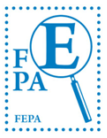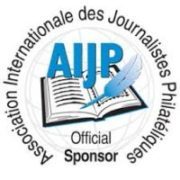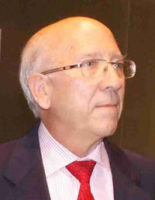AIJP Congress: Wolfgang Maassen Presentation


Left, the logo of the ‘Association Internationale des Journalistes Philatéliques’, AIJP. Right the President Wolfgang Maassen
Philatelic literature at exhibitions:
a critical examination
By Wolfgang Maassen
For almost 40 years, the author of this article has been exhibiting at international and national exhibitions. He has seen a great deal and has often wondered how negligent, careless and at times loveless philatelic literature was treated at such events. And this not only in terms of their presentation, be it on the event itself or in their presentation in the event’s catalogue. The way a substantial number of jurors deliver their work also makes it difficult to have unlimited faith in their competence and experience.
Now, critical thoughts on such topics are not new. And the responsible associations or the organizers of the exhibitions are fully aware of them. In the past, they have reacted to such criticism by developing regulations, guidelines and recommendations that were designed to help the organizers to avoid mistakes and prevent shortcomings that could put exhibitors at a disadvantage. But all this cannot hide the fact that paper always will be patient and that even strict, clearly defined rules are not always respected or complied with.
Already this allegation may be felt by some as a tough statement. But it is a statement that can be proved, as has recently been done by this author in “The Philatelic Journalist”, issue No. 156 (July 2018), in his article “Unter die ‘Räuber’ gefallen? Ein ‘Trauerspiel’ für Literatur-Aussteller” (“In the Hands of Robbers? A Tragedy for Literature Exhibitors”). Because in this article, the examples of the FIP exhibitions ISRAEL 2018 and PRAGA 2018 show the contradiction between the existing regulations and reality. One can only draw the conclusion that for this contradiction not only the event organisers are to blame, but first and foremost the authorities that have granted their patronages (especially the FIP), but apparently do not pay attention to compliance with existing regulations. The FIP appoints a coordinator for every exhibition it gives its patronage: a member of the Board whose job it is – or at least should be – to ensure compliance with the existing regulations. But all too often this obligation only exists on paper; the reality looks different. Not just in individual cases, but even more in general.
Thus it seems appropriate to make up a list of existing and well-known grievances and plead for an immediate secondment. The AIJP sees itself as a lawyer for its authors and publicists, whom they want to provide a public podium, so that their voices can be heard. Conceivably – as the author has hinted before – the result could be a list of “anti-author and anti-collector exhibitions” (like the one the FIP maintains for harmful stamp issues). Such a list of negative AIJP ratings could then be presented to future events that violate the existing rules to the limit. In order to make this process more transparent, and also to find out the reasons and justifications (i.e. criteria) for such assessments, the most important matters are listed below.
Regulations for Philatelic Literature
As “Guidelines” are destined the “Special Regulations for the Evaluation of Philatelic Literature Exhibits at F.I.P. Exhibitions”, along with the “Supplementary Rules for the Philatelic Literature Class in F.I.P. Exhibitions”. It is the merit of the F.I.P. to have set the standards that are binding for its national members, including the events they organise. In this respect, it should be welcomed if philatelic literature in general would be represented with its own exhibition class at philatelic events. But that cannot hide the fact that what has been put to paper and how things are implemented in the real world often diverge considerably. Below will give you examples of these divagations.
- Subgroups of the Philatelic Literature Class
In the „Special Regulations“ of the FIP the following remarks can be found:
“Philatelic literature will be subdivided as follows:
1. Handbooks and Special Studies
- Handbooks
b. Monographs
c. Specialised research articles
d. Bibliographies and similar special works
e. Exhibition catalogues
f. Specialised catalogues that – besides philatelic issues of one or more countries – treat varieties, cancellations or other specialized aspects.
g. Transcripts of philatelic lectures presented to the public (including radio, television, film and slide show scripts).
h. Similar special works. - General Catalogues
Worldwide, regional and single area catalogues whose depth of coverage do not qualify them as specialized catalogues. - Philatelic Periodicals
Philatelic journals and newspapers, society journals, house journals, yearbooks and similar publications. - Articles
Articles of a general nature, in philatelic or non-philatelic publications.”
As you can see literature of a digital kind is missing completely, although this constitutes a worldwide market and digital literature has been published for many years now. The FEPA already has its own regulations, and the national associations in countries such as Italy, Germany or Spain created regulations for the evaluation of digital literature already six or more years ago. Until this day, only the F.I.P. has not implemented regulations of this kind.
In the case of group 4 (“Articles”), one wonders what the relevance may be of this category, even if it says: “A selection of at least ten different articles is required for exhibition”. This group emerged at a time when authors combined a number of their own contributions as an offprint, which then became a publication. Today, this practice has long since become obsolete; such “articles” barely have any right to be admitted to an exhibition. Similarly, some of the subgroups mentioned under Group 1 are also of a dubious kind, since they are – at least from the author’s point of view – outdated.
- Time limits for the exhibition of philatelic literature
In the “Supplementary Rules” of the FIP it says:
“Rule 8: Handbooks and special studies must have been published not earlier than 5 years prior to the exhibition year. For all other entries the publication date should not be earlier than 2 years prior to the exhibition year. For multivolume works, the date of publication of each volume shall govern. Revised editions will be considered as new publications. For periodicals, the most recent complete volume or year shall be exhibited. A selection of at least ten different newspaper articles is required for exhibition.”
Of course it is possible to discuss about the length of time limits. What should be determinative: the moment an exhibitor applies for participation or the date on which the exhibition officially begins?
PRAGA 2018 has formulated it this way:
“Philatelic books and research paper (published after 1st January 2014)
Philatelic magazines and periodicals (published after 1st January 2017)”
In other words: no period of five years for the first category and no period of two years for the other, but instead of that one year less in both cases. The regulations allow this approach, but does it make any sense? Why such tight time limits, especially when it regards monographs or handbooks? Wouldn’t it be better to describe these time limits differently, for instance with the remark ‘if still available’? This would be in the interest of the publicist, because he of course wants to promote his publications, no matter how old they are. Otherwise, any time limit remains arbitrary.
- Number of philatelic literary exhibits
The “Supplementary Rules” state:
“Rule 5:
Two copies of each literature exhibit should be provided by the exhibitor: one copy for judging and the other for a reading room as per Article 6.8 of GREX. After the exhibition these copies shall be sent by the Exhibition Management to a library designated by the member federation hosting the exhibition, unless the exhibitor specifically asks for the return of these copies.” (emphasis added by the author)
This is one of the rules that is not met by most FIP exhibitions, but others also fail to do so. Although it is clear that the exhibitor must have the opportunity to have his submitted exhibits sent back to him, this facility is hardly ever offered. Precisely at this point the FIP coordinators cannot be spared the accusation that they either do not know their own regulations or do not press for their observance.
In addition, the provision that two copies of a literary exhibit must be submitted is questionable. The indirect reasoning that the jury must have at least one exhibit available for evaluation is not sustainable, because the jury could also review them in a public reading room (which they do with stamps exhibits too). Since the jury usually starts with its work before the exhibition opens, this would be absolutely no problem. A reading room for the issued philatelic literature is compulsory (even if not every exhibition applies to this rule).
That at the same time exhibitors are required to send in their exhibits two or even three months in advance, in order to enable the jurors to do their work before the exhibition begins, is rather odd. Why then should there be a second copy available at all?
The remark that two copies of each exhibit will to be donated to libraries that will be selected by the organization management means a clear interference with the self-determination and ownership rights of an exhibitor. After all, exhibits containing stamp collections or other philatelic material are not withheld; they will go back to their rightful owners. Literature exhibitors have the same rights. So you must decide for yourself to whom your exhibit will go after the exhibition: to yourself, to the exhibition management or to one or more libraries of your choice.
- The special literature registration form
About the special literature registration form the “Supplementary Rules” state the following:
“Rule 4:
A separate form will be used for entries in the literature class. In addition to the other information needed by the Exhibition Management, this form should also include the publication date, publisher, number of pages, frequency of publication (for periodicals) and means of ordering the publication (address, price).”
There is no doubt that this rule makes sense, but only if it is used consistently and further processed. But that is hardly the case. In exhibition catalogues usually only the author (read: the exhibitor) and title of his exhibit are mentioned. And that’s all. Even in the literature reading room (if such a facility exists) you will not find these data in the exhibited works! What purpose does it serve then?
An exhibition is not meant for jurors, but for visitors. In this case for those interested in philatelic literature. When they have a look at the exhibited books and get interested in one or more of the titles, they without doubt will want to know what their selling price is and where the can eventually buy them. Exactly for this purpose a special literature registration form should be designated, but only if it it’s available for the visitors. The form should at least be available on the exhibition’s website and in the exhibition’s reading room.
Exhibitions should feel obliged to do as described above. Otherwise literature exhibits only serve the exhibition itself and not the visitors – let alone the exhibitors, who have paid for the inclusion, presentation and promotion of their exhibits.
- Submission period of literature exhibits
As a rule, international and national exhibitions demand an early submission of the exhibits. They are often expected to arrive two to three months before the exhibition begins. It’s a rule that sounds rather nonsensical, considering that the jurors begin their work mostly only one or two days before the exhibition opens its doors, i.e. from the moment that the respective national commissioners (or the exhibitors themselves) could have submitted their literature exhibits along with the ‘normal’ exhibits (containing stamps, covers and other philatelic material.
One gets however the impression that neither the FIP nor the exhibition organizers are interested in this matter, and one wonders what the possible reasons are for this display of disinterest. Because the assigned national commissioners usually are interested in a high numbers of participants (the organizers anyway) because the exhibitors have paid for their participation. The pre-shipment rule of 2 to 3 months could therefore give the impression that exhibitions are happy to collect the participation fees, but not so keen on providing the necessary performance. This kind of disinterest can for instance be proven by looking at the example of the German Association of Stamp Collectors (BDPh). The author of this article has spoken to several of the BDPh’s commissioners, and they have told him in no unclear terms that it’s their habit to charge the normal commission fee (currently 30 euros per exhibit) for judging literature exhibits (and that in our age of pdf files that hardly need any significant work). The Commissioner’s fee is simply designed to finance travel and subsistence expenses. With which right literature exhibitors are charged additional costs one may well ask here.
A pre-shipment rule of two to three months before the event should apply only in a few cases: for instance when a period of such length is absolutely necessary for a fair and proper assessment of an exhibit.
- Exhibit fees
Also on the point of the exhibition fees, the “Supplementary Rules” provide information:
“Rule 6:
The same applies to the price of one frame in the general competition class of the same exhibition.”
Now one can – if he or she wishes – have long and extensive discussions about the amount of the exhibit fees. For national exhibitions, rates between 20 and 30 euros are usually the rule, at international events the fee is often double or more and sometimes the fees are even triple the normal rate. This seems to be unjustified: for the evaluation of philatelic literature it does hardly matter whether it concerns a national or an international exhibition. It may be undisputed that an international exhibition has higher costs than some national ones. But in the past the author has repeatedly argued that the efforts that have to be made for the accompaniment of a literature exhibit – both in terms of assigning exhibition space and the deployment of personnel – are considerably smaller than the efforts that are necessary for the proper accompaniment of exhibits containing stamps, covers and other material.
Even more remarkable is the fact that international exhibitions (for example PRAGA 2018) do not adhere to the instructions that can be found in the Supplementary Rules. Because in Prague for a frame showing stamps etc. 70 euros was charged, whilst for every single literature exhibit 75 euros had to be paid! A clear violation of the FIP regulations; one may ask oneself how this can be justified and also may wonder how serious the FIP takes its role as supervisor in these cases.
Totally unacceptable is the behaviour of those exhibition organizers that dictate that literature exhibitors may have to pay custom duties for their exhibits, as was the case with ISRAEL 2018, whose IREX stated in section 10.9: “If the declared value is above US $ 75 the Organizing Committee must pay a VAT of approximately 20% (including postage). In this case the commissioner of the exhibitor will pay the same.”
So literature exhibitors are urged to send in their own exhibits at their own expense – of course twofold – and then asked to leave their exhibits as a “gift” to the organizers, i.e. not asking to send them back, and on top of this pass eventual custom fees from the organizer to the exhibitor! Again, this is not sustainable and unlawful according to the FIP regulations as they are at the moment. It would also be completely unnecessary if the organizer would comply with the applicable rule that each exhibitor has the right to import and return his exhibit, similar to the way stamp exhibits are treated.
A FEPA proposal (see FEPA News, June 2018, p. 10) lautet: “As in some countries VAT must be paid for items with a value over 50 Euro, we advise exhibitors to add pro forma invoice in amount lower than 50 Euro to every example of literature.”
Now I am not sure if it is correct to speak of VAT (= Value Added Tax) or rather ‘Einfuhrumsatzsteuer (“import sales tax”). But that is less of a concern. Personally, I think the recommendation of the FEPA to define the value of a book or other literature exhibit much lower than its actual value could be very problematic, as this is a violation of existing law. The country in question is thus deprived of the tax it is entitled to. To put it harshly: this is a fraudulent offense which, if discovered, could lead to a punishment.
All this would be completely unnecessary if the exhibitor, as he or she is entitled to, would receive his or her precious exhibits back, just as is the case with ‘normal’ exhibits (containing stamps, covers and other material). In that case it would concern a matter of tax-irrelevant import and export, at least when import and export would be clarified in advance by showing the the appropriate customs documents.
- Medals and other literature awards
Even medals and other awards for literature exhibits are mentioned in the “Supplementary Rules”:
“Rule 9:
Medals in the literature class will bear the word ‘Literature’ either abbreviated or in full. Literature entries are also eligible for special awards (Article 8.6, GREX).”
That may sound really fine, were it not that your author hardly ever had the experience of receiving a medal or an award with the inscribed addition ‘literature’. Exhibition organisers – local as well as international – mostly use uniform medals and awards that they hand out for all kinds of exhibits. Since a number of years the organisers of most exhibitions don’t even bother to have the names of the awardees engraved in the medals that they hand out, apparently for cost reasons. “Special awards” are also a relatively unknown concept. At least they are very rare.
One may well wonder why literature exhibits are not given a chance to win the Grand Prix Award of an exhibition. It can be deduced why this is so when you look at the points that the jurors give to ‘normal’, respectively ‘literature’ exhibits. It is clear that even when a literature exhibit manages to collect a top rating – let’s say 95 or even 96 points – this will be not enough to enter the pot containing the names of the Grand Prix nominees. It seems certain that none of the jurors could explain convincingly why he awarded a certain literature exhibit only 96 points and not 98 points. But the reason is obvious: because it is undesirable that a literature exhibit may ever receive a Grand Prix at an International Exhibition.
Once again, this proves why literature exhibits and stamp exhibits are treated so unequally: for “political reasons”. People may differ as far as the allocation of juror points is concerned, but not about the requirement that exhibits should have the same chance at an exhibition, simply because there is not such a thing as a “first class” or “second class” exhibitor.
Presentation of literature exhibits
Earlier in this article the author argued that the presentation of literature exhibits at exhibitions is very important. Not only for the visitors, but also for the respective exhibitors. Let’s repeat the two main points once again.
- Presentation in the catalogue
In a time where financial resources are scarce, publishing a printed exhibition catalogue is becoming an ever growing obstacle for many an organizer. Exhibitors and visitors alike have the almost indisputable right to know the details of the exhibits, especially where and from whom (in the case of literature exhibits) they can obtain them and at what price.
Organizers usually limit themselves to publish a short list of the exhibits, which, however, does not help much. Even digitally, additional data (see the information in the special literature registration form) are not provided. The author finds this unacceptable since at least the latter (providing digital data) would be an easy thing to do.
There are certainly other solutions that could make the production of a printed exhibition catalogue still possible. One could – like the organisers of STOCKHOLMIA 2019 managed to do – attract a powerful main sponsor, or one could try to refinance the cost of the exhibition catalogue by placing advertisements in it.
The international exhibition LONDON 2015 (and presumably also LONDON 2020) has sought the assistance of the AIJP. The AIJP not only realizes the reading room – thanks to the support of individual sponsors – but is also responsible for the production of a special literature catalogue that serves as an extensive annex of the main catalogue. Many things are still feasible, as long as one does not treat the exhibitors as a “milk cows” that need to be milked extensively.
- Presentation in the reading room
On many national exhibitions, the author of this article has searched for a separate reading room – a reading corner would already be fine – but failed to find it. There is an obligation to offer such a facility, because every exhibit has to be visible to the visitors. It’s really a shame when – as happened in Heidelberg 2016 – literature exhibits are stowed away behind the windows of the caretakers lodge. Such a ‘solution’ is no use to anyone.
Some of the exhibitions have been instrumental in creating perfectly suited, generously and comfortably furnished reading rooms with writing desks and shelves. But when we talk about reading rooms we don’t always have to think in terms of deluxe class models like those. The NOTOS exhibition in Athens showed some years ago that it is perfectly possible to go for a more simple and still quite functional setting: by using a kind of IKEA shelves and setting up a number of small bistro tables. There was no supervision and still nothing was stolen during NOTOS. The latter was also the case at BRASILIANA 2013 in Rio de Janeiro; nothing disappeared there either.
The demand for reading rooms can be sometimes enormous. At LONDON 2015, more than one thousand visitors were counted in the few days that the exhibition lasted! This is something that organisers of philatelic events should take into account. It is clear that the presence of an adequately furnished, attractive reading room may inspire a significant number of people to pay the event a visit.
Individual problem areas
The mostly critical thoughts mentioned so far are not the only ones that go through one’s mind when thinking about the organization and realization of exhibitions. There still are a few that deserve further consideration.
- Literature jurors
For cost reasons, national and international exhibitions often lack the presence of experienced and competent jurors, people who are specialized in philatelic literature. As a rule, the organisers seem to prefer to resort to jurors who are competent in two or three competition classes (such as Postal History, Thematic Philately or Traditional Philately), but also claim additional skills in the field of judging philatelic literature.
Some of them may not be regarded as special literature connoisseurs (they are just trying to increase their chances of employment) and they often have only adequate expertise as far as their own collection areas are concerned. You could compare this with an international “Animal Show” that tries to persuade jurors that are specialized in judging dogs or cats to take a shot at rating butterflies at well.
Now this comparison may limp a bit, but it is not wholly off the mark. In his years as a literature juror this author has experienced that a number of his so-called colleagues – often ‘top notch’ in their own fields, like Traditional Philately or Postal History) were able to describe the look and feel of a book and to grasp its general logic thanks to its table of contents. Otherwise, however, they clearly lacked expertise on such important fields as relevance, level of research and presentation. Their ratings were almost all the time based on “formal” criteria.
A number of individual international jurors can be specially overwhelmed when they are unfamiliar with the language of an exhibited work. If at an exhibition in Asia only jurors are used that as their “secondary qualification” have mentioned the evaluation of literature, but apart from their own Asian language only speak English, how could these jurors be suited to make a proper evaluation of a literature exhibit written in German or in any other language? It is obvious that the resulting reviews were made rather by looking at the name of the author of the exhibit, instead of having being created by means of an attentive and understanding study of the work in question.
Here again, a “rethink” is required. The author of this article is well aware that especially those jurors who at a given exhibition already have to judge many stamp exhibits, hardly will find the time to have a close and detailed look at the literature exhibits they are expected to evaluate, let alone that they are able to understand the scope and importance of these exhibits. Even if a juror is provided three months in advance with a list that mentions the titles of the literature exhibits, he can hardly prepare himself thoroughly. Especially not if he lives in a country where one does not have access to a well-equipped philatelic library, a place where he could borrow the titles that he wants to study more thoroughly.
Philatelic literature is usually written in the native language of the author of the exhibit. This means that the problem of understanding the scope, importance and relevance of the exhibits can’t be solved. Because just like we are barely to read or understand the Asian languages, the jurors coming from these countries will have their problems when they try to evaluate literature exhibits that are written in other languages than English, like Bulgarian, Russian, Greek or even German. A juror could of course ask one of his colleagues for help, but would this colleague be able to understand philatelic literature? And would he have ample time to study literature exhibits in detail?
We have here a problem that even this author does not know how to solve it in satisfying way. A normative rule that only philatelic literature written in English may participate in an literature exhibition – as usual in American exhibitions – does not solve this problem. On the contrary: it excludes others who also have the right to publish their books in their home language.
- Homepage, journalism and the public sphere
More and more, organizers opt for the creation of a solid homepage (website) for their event, but in doing so they often neglect the written and unwritten rules of classic journalism. Attempts trying to attract visitors exclusively via the Internet hardly ever succeeds; therefore more is needed. For example, continuous (!) press activities, the deliverance of constant exhibition news, maintaining an image service, but also intensive editorial activities.
Of course, the output of classic ‘ink to paper’ activities and the advantages that the digital media have to offer can (and should) complement one another. It is important to realize that their contents should be produced in a professional fashion. Just like there is only a select number of people that can write bestsellers, not everyone who can write will be able to do this in a professional way and using an entertaining style.
The author of this article – who in the past actively helped to organize several international and national exhibitions – has in that capacity acquired an useful experience: he has found out that disappointing visitor numbers often have nothing to do with the quality of the exhibition or its exhibits, but rather with the fact that potential visitors weren’t aware of the upcoming event, due to a lack of promotion. Successful marketing – which also includes Public Relations and Press Support – requires sophisticated structures, competent journalists and the right channels to disseminate these messages.
In this field, the AIJP can offer help, if the organizer wishes so and the AIJP is prepared to lend the event its patronage. This will cost money of course, but far less than you would expect for the services provided. For the organiser this means that he will have to create certain conditions. It would require the creation of a special literature reading room, that eventually also can act as a press centre. It’s a requirement that easily could be met. Free entry for journalists should also be possible, although many organisers seem unwilling to create such a facility. This is difficult to understand; it’s a kind of misplaced economy that in the end only harms the event itself.
Looking at the future, only a few positive developments are to be expected. It is completely unclear on what moment the FIP – especially the Commission for Philatelic Literature of the FIP – will finally adapt its regulations in such a way that they meet today’s developments and requirements. Even the FEPA seems lags a bit behind, because it seems more interested in regulations than in the number of visitors an exhibition may attract.
However, a lot is also feasible, as I have substantiated in the text of this article. As already said, an exhibition is not for jurors, even less for associations, but primarily and exclusively for the visitor. Only when one understands and applies this marketing concept, one will know how to set the required positive accents.
Translation: Aad Knikman



